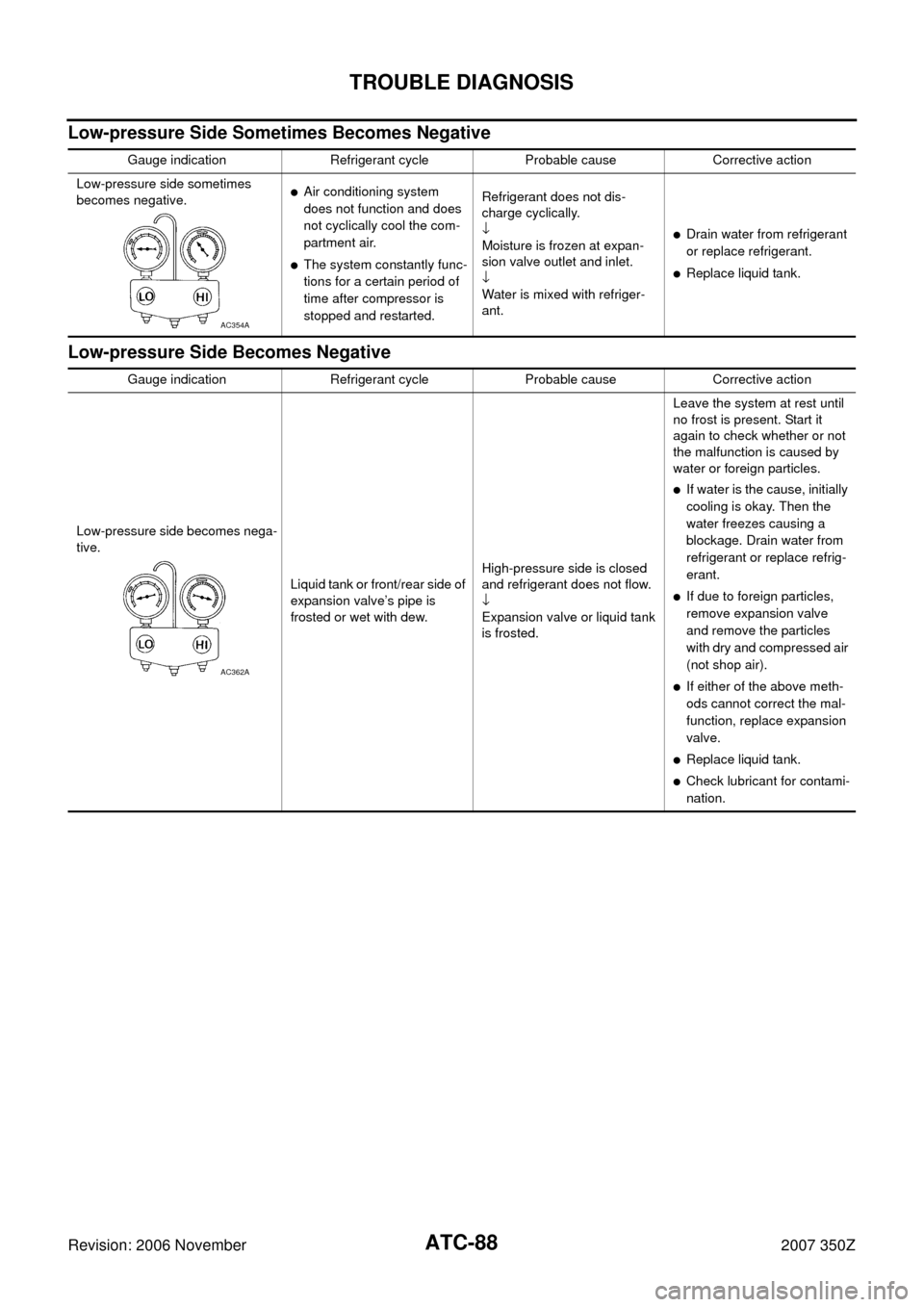Page 6 of 142

ATC-6
PRECAUTIONS
Revision: 2006 November2007 350Z
General Refrigerant PrecautionsNJS00004
WARNING:
�Avoid breathing A/C refrigerant and lubricant vapor or mist. Exposure may irritate eyes, nose and
throat. Remove HFC-134a (R-134a) from the A/C system, using certified service equipment meet-
ing requirements of SAE J-2210 [HFC-134a (R-134a) recycling equipment], or J-2209 [HFC-134a (R-
134a) recovery equipment]. If accidental system discharge occurs, ventilate work area before
resuming service. Additional health and safety information may be obtained from refrigerant and
lubricant manufacturers.
�Never release refrigerant into the air. Use approved recovery/recycling equipment to capture the
refrigerant every time an air conditioning system is discharged.
�Always wear eye and hand protection (goggles and gloves) when working with any refrigerant or
air conditioning system.
�Never store or heat refrigerant containers above 52°C (126°F).
�Never heat a refrigerant container with an open flame; if container warming is required, place the
bottom of the container in a warm pail of water.
�Never intentionally drop, puncture, or incinerate refrigerant containers.
�Keep refrigerant away from open flames: poisonous gas will be produced if refrigerant burns.
�Refrigerant will displace oxygen, therefore be certain to work in well ventilated areas to prevent
suffocation.
�Never pressure test or leak test HFC-134a (R-134a) service equipment and/or vehicle air condition-
ing systems with compressed air during repair. Some mixtures of air and HFC-134a (R-134a) have
been shown to be combustible at elevated pressures. These mixtures, if ignited, may cause injury
or property damage. Additional health and safety information may be obtained from refrigerant
manufacturers.
Page 85 of 142

TROUBLE DIAGNOSIS
ATC-85
C
D
E
F
G
H
I
K
L
MA
B
AT C
Revision: 2006 November2007 350Z
PERFORMANCE CHART
Test Condition
Testing must be performed as follows:
Test Reading
Recirculating-to-discharge Air Temperature Table
Ambient Air Temperature-to-operating Pressure Table
Vehicle condition Indoors or in the shade (in a well-ventilated place)
Doors Closed
Door windows Open
Hood Open
TEMP. Max. COLD
Mode control dial
(Ventilation) set
Intake switch
(Recirculation) set
Fan (blower) speedMax. speed set
Engine speed Idle speed
Operate the air conditioning system for 10 minutes before taking measurements.
Inside air (Recirculating air) at blower assembly inlet
Discharge air temperature at center ventilator
°C (°F) Relative humidity
%Air temperature
°C (°F)
50 - 6020 (68) 6.1 - 8.7 (43 - 48)
25 (77) 8.5 - 11.5 (47 - 53)
60 - 7020 (68) 8.7 - 11.1 (48 - 52)
25 (77) 11.5 - 14.5 (53 - 58)
Ambient air
High-pressure (Discharge side)
kPa (kg/cm
2 , psi)Low-pressure (Suction side)
kPa (kg/cm2 , psi) Relative humidity
%Air temperature
°C (°F)
50 - 7020 (68)850 - 1,050
(8.67 - 10.71, 123.3 - 152.3)180 - 230
(1.84 - 2.35, 26.1 - 33.4)
25 (77)1,020 - 1,260
(10.40 - 12.85, 147.9 - 182.7)190 - 240
(1.94 - 2.45, 27.6 - 34.8)
30 (86)1,150 - 1,410
(11.73 - 14.38, 166.8 - 204.5)210 - 250
(2.14 - 2.55, 30.5 - 36.3)
35 (95)1,240 - 1,510
(12.65 - 15.40, 179.8 - 219.0)220 - 270
(2.24 - 2.75, 31.9 - 39.2)
Page 88 of 142

ATC-88
TROUBLE DIAGNOSIS
Revision: 2006 November2007 350Z
Low-pressure Side Sometimes Becomes Negative
Low-pressure Side Becomes Negative
Gauge indication Refrigerant cycle Probable cause Corrective action
Low-pressure side sometimes
becomes negative.
�Air conditioning system
does not function and does
not cyclically cool the com-
partment air.
�The system constantly func-
tions for a certain period of
time after compressor is
stopped and restarted.Refrigerant does not dis-
charge cyclically.
↓
Moisture is frozen at expan-
sion valve outlet and inlet.
↓
Water is mixed with refriger-
ant.
�Drain water from refrigerant
or replace refrigerant.
�Replace liquid tank.
AC354A
Gauge indication Refrigerant cycle Probable cause Corrective action
Low-pressure side becomes nega-
tive.
Liquid tank or front/rear side of
expansion valve’s pipe is
frosted or wet with dew.High-pressure side is closed
and refrigerant does not flow.
↓
Expansion valve or liquid tank
is frosted.Leave the system at rest until
no frost is present. Start it
again to check whether or not
the malfunction is caused by
water or foreign particles.
�If water is the cause, initially
cooling is okay. Then the
water freezes causing a
blockage. Drain water from
refrigerant or replace refrig-
erant.
�If due to foreign particles,
remove expansion valve
and remove the particles
with dry and compressed air
(not shop air).
�If either of the above meth-
ods cannot correct the mal-
function, replace expansion
valve.
�Replace liquid tank.
�Check lubricant for contami-
nation.
AC362A